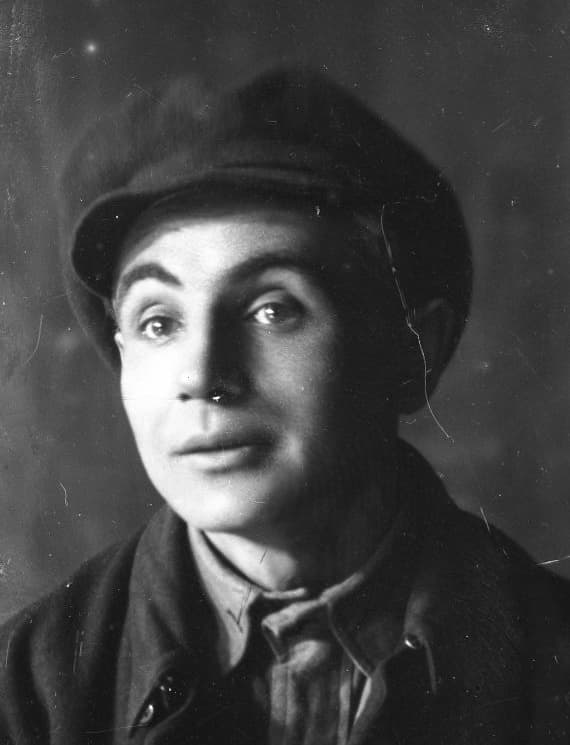Based on the play by Volodymyr Vynnychenko
Premiere: February 1, 1919
Director: Hnat Yura
Artist: Stepan Hrechanyi
Maria Andriievna Liashkivska – Polina Samiilenko
Nina, Her Friend – Olimpiia Dobrovolska
Ivan Chobotar, Nina’s Husband – Oleksii Vatulia
Olena Karpivna, Nina’s Aunt – Olha Horodyska
Ivan’s Friends:
Anhelok – Stepan Bondarchuk
Mykhas Seredchuk – Valerii Vasyliev
Pavlo Seredchuk, Mykhas’s Father – Yona Shevchenko
Stalynskyi, Gendarme Lieutenant Colonel – Semen Semdor
Nizdia – Vasyl Vasylko
Watchman – Lenoid Boloban
Bailiff – Lev Piasetskyi
Policemen:
- Leonid Predslavych
- Oleksa Hresko
- Hnat Balinskyi
The Sin, based on Volodymyr Vynnychenko’s play, was Hnat Yura’s fourth and final directorial piece at the Young Theater. Les Kurbas was lukewarm towards Vynnychenko’s work, while Yura was a sincere fan. The playwright personally gave the theater the play and it was performed on stage for the first time on February 1, 1919.
After watching it, journalist Andrii Nikovskyi said The Sin, unlike the rest of Vynnychenko’s plays, “was carefully done.” “Almost all the characters,” he wrote, “are colorful types, and, more importantly, nowhere in the play is there the slightest psychological falsehood or artificiality, everything is smooth, simple, natural and clear; interest in the play lasted from start to finish.”
The Sin was about the transformation of a decent person into a traitor under the pressure of circumstances. Gendarme Stalynskyi, with great pleasure, forced revolutionary Maria onto this path. Driven to despair, the heroine ended her life by suicide.
The show’s strong point was the ensemble of actors. Even the smallest roles were nuanced, but Nikovskyi underlined that the “garland of victory” was worn by Semen Semdor, who played the role of Gendarme Stalynskyi. He made the strongest impression on the audience and in this role “played a psychologically truthful and colorful gendarme lieutenant colonel who was predatory and cynically cruel.” An important aspect of the role was that Semdor didn’t make his character unpleasant or ugly through makeup or clothes: on the contrary, he looked like a good-natured, even decent man, and only during the performance was his rotten essence revealed. It’s no wonder his subordinates called him Herod. Director Yura said that Semdor in the role of Stalynskyi created an image of a hideous sadist and “poet of wickedness.”
The powerful and convincing acting and highly charged political situation in the country once almost led to a tragedy. Actress Polina Samiilenko (who played Maria) recalled: “I played the heroine and S. Semdor played the gendarme. A Red Army soldier wanted to shoot Semdor with his rifle during the scene where the gendarme is questioning Maria, but his comrades stopped the impressionable spectator who though the theater stage was reality.”
Polina Samiilenko also created a strong image, but Nikovskyi advised her to work on the finale, where the heroine kills herself. “The final chord (Maria’s death),” he wrote, “was pale and colorless because Ms. Samiilenko didn’t show the boundless despair that pushes a tormented person to take this step.” Maybe his assessment was limited to her performance in the premiere, because the play’s director, Hnat Yura, said that in the final scene the actress played her role very dramatically.
In describing his work on the play, Yura noted that he made the production realistic, with an emphasis on social and psychological moments. The artistic design of the play was also realistic. Commenting on the work of artist Stepan Hrechanyi, the director recalled: “The set recreated the atmosphere of the living room in revolutionary Maria’s apartment: simple furniture, modest decoration. Outside the windows you could see the tops of trees, emphasizing that the action took place on the second floor of a city building. This helped convey the atmosphere of the gendarme raid, the sound of vans approaching, the police whistles, the stamping of military boots on the stairs and cobblestones. Although sparse in details, the atmosphere of the investigator’s cell was also accurately conveyed.” However, the critics did comment about the reality of the set design. Nikovskyi wrote that the view from the window in the first act looks very unrealistic. “The landscape is painted in sharp, dark tones without aerial perspective, which gives the impression not of distance but just an ordinary painting in the window.”
Other actors singled out by reviewers included Vasyl Vasylko in the role of the weak-spirited informer Nizdia, Oleksii Vatulia as revolutionary Ivan, Yona Shevchenko as Mykhas’s father, Stepan Bondarchuk as Anhelyk, and Olimpiia Dobrovolska as Nina.
Hnat Yura’s show received positive and warm reviews from critics and spectators alike, and prompted the director to search for his path in art outside of the Young Theater. After this production the rift between Kurbas and Yura, primarily due to aesthetic and artistic differences, became obvious. Yura, in his own words, aspired to realistic, psychological art, while Kurbas wanted to experiment, discover the new and unknown, create a new era of theater.

